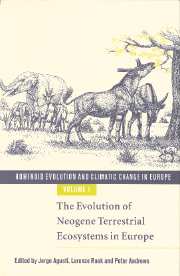Book contents
- Frontmatter
- Contents
- List of contributors
- Acknowledgements: The European Science Foundation
- 1 Introduction
- PART I Palaeogeography of the circum-Mediterranean region
- PART II Miocene mammalian successions
- PART III Palaeoenvironments: non-mammalian evidence
- 14 Marine invertebrate (chiefly foraminiferal) evidence for the palaeogeography of the Oligocene–Miocene of western Eurasia, and consequences for terrestrial vertebrate migration
- 15 Palaeoclimatic implications of the energy hypothesis from Neogene corals of the Mediterranean region
- 16 Contribution to the knowledge of Neogene climatic changes in western and central Europe by means of non-marine molluscs
- 17 Sedimentary facies analysis in palaeoclimatic reconstructions. Examples from the Upper Miocene–Pliocene successions of south-central Tuscany (Italy)
- 18 Neogene vegetation changes in West European and West circum-Mediterranean areas
- PART IV Palaeoenvironments: mammalian evidence
- Index
16 - Contribution to the knowledge of Neogene climatic changes in western and central Europe by means of non-marine molluscs
from PART III - Palaeoenvironments: non-mammalian evidence
Published online by Cambridge University Press: 15 December 2009
- Frontmatter
- Contents
- List of contributors
- Acknowledgements: The European Science Foundation
- 1 Introduction
- PART I Palaeogeography of the circum-Mediterranean region
- PART II Miocene mammalian successions
- PART III Palaeoenvironments: non-mammalian evidence
- 14 Marine invertebrate (chiefly foraminiferal) evidence for the palaeogeography of the Oligocene–Miocene of western Eurasia, and consequences for terrestrial vertebrate migration
- 15 Palaeoclimatic implications of the energy hypothesis from Neogene corals of the Mediterranean region
- 16 Contribution to the knowledge of Neogene climatic changes in western and central Europe by means of non-marine molluscs
- 17 Sedimentary facies analysis in palaeoclimatic reconstructions. Examples from the Upper Miocene–Pliocene successions of south-central Tuscany (Italy)
- 18 Neogene vegetation changes in West European and West circum-Mediterranean areas
- PART IV Palaeoenvironments: mammalian evidence
- Index
Summary
Introduction
During the nineteenth century and the first half of the twentieth century, a great number of papers on Cenozoic fossil European non-marine molluscs were published. After the Second World War the number of publications dealing with fossils of this group decreased and among the relatively limited number of papers published since then the majority regards malacological assemblages of the Quaternary period. Many faunas must be revised and consequently their utility for paleoclimatical, paleoecological or paleogeographical purposes is very limited.
The potentiality of non-marine mollusc fossil assemblages to the reconstruction of paleoclimates has been clearly evidenced by many works of many malacologists working on the Quaternary (Lozek, 1964; Puisségur, 1976). The majority of the species recorded in sediments of this period (especially of middle and late Pleistocene and Holocene) are still living and a quantitative analysis of the composition of the fossil assemblages gives very accurate information about the local climatic conditions. This fact is strictly linked to the onset of the main glaciations just at the beginning of the middle Pleistocene. Unfortunately this situation is not the same for older periods in which the climatic changes were not so sharp and the majority of the fossils belong to extinct species. Since the shell morphology of land species generally is not affected by climatic variations, the information about environmental changes is inferred indirectly considering other factors: the occurrence or disappearance of the taxa, their geographic distribution (also in connection with the latitude and elevation, for example, of living species of the same genus), the degree of the species diversity of the assemblages.
- Type
- Chapter
- Information
- Hominoid Evolution and Climatic Change in Europe , pp. 328 - 354Publisher: Cambridge University PressPrint publication year: 1999
- 4
- Cited by



